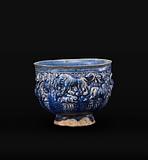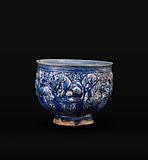A lively hunting scene done in high relief adorns this elegant, thin-walled bowl. Armed with bows and arrows, swords or lances and shields, three horsemen at full gallop and a single man on foot all combat three fearsome lions. A hare and several birds hide in fright among the vines in the background. Above the wide pictorial frieze is a border with interwoven rope ornamentation, while below it, a frieze with an undecipherable Arabic inscription in
naskh script appears. The hemispherical bowl rests on an outward-sloping, unglazed foot with vertical grooves. Both the interior and exterior of the bowl are covered in a blue glaze, and where the relief is most pronounced, the white colour of the fritware is visible, highlighting the motifs.
The design of the bowl was devised by a moulder who first crafted an original clay model identical in shape to the finished bowl but solid all the way through. From this original, multiple negative clay moulds could then be produced in two halves. The potter could use these moulds to cast the two halves of the bowl, which were later joined together to form the final unglazed piece.
[1] For this reason, multiple bowls with the same design exist, some with different glazes and even with delicate openwork perforations that lend a degree of transparency to the object.
[2]






